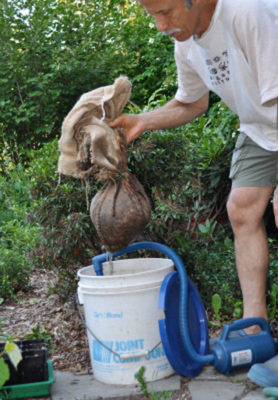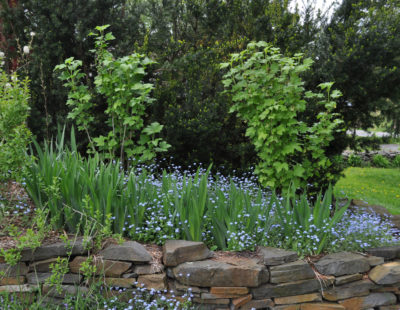Uncommon But Uncommonly Delicious
Some (Only) Like It Cooked
Before the black currant (Ribes nigrum) season totally winds down, I suggest you try to get a taste of the fresh berries. Do so if you’ve never tasted them. And do so even if you have tasted them and found them bad tasting.
Why taste them if you haven’t? Because if you end up liking them, they’re easy to grow and nutritious — super-rich in vitamin C (2 to 3 times as much as oranges) and other goodies.
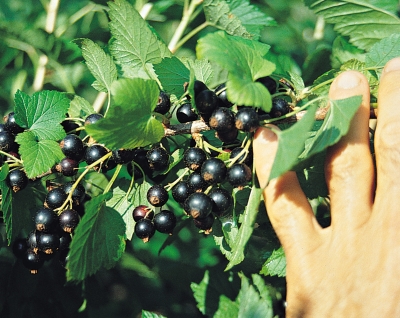
Belaruskaja black currants
Deer don’t particularly like the very aromatic stems and leaves, and birds — even my ducks — ignore the berries. They are among the few berries that thrive and bear well even in some shade. They have few insect or disease problems.
And the berries taste good, very good, some varieties better than others. My “currant” favorites are the varieties Belaruskaja and Titania, either of which I recommend tasting if you’ve previously had a bad gustatory experience with black currants.
Then again, black currants have a strong flavor. Not everyone has to like them. What Liberty Hyde Bailey, the “father of American horticulture,” wrote about apples in 1922 would apply equally well to kinds and varieties of fruits, including black currants: “Why do we need so many kinds of apples? Because there are so many folks. A person has a right to gratify his legitimate tastes.“
Then again — again — just about everybody likes black currants concocted into a jam, a pie, a syrup, or an alcoholic drink (as in casis). I like mine straight up, fresh in summer, frozen and defrosted in winter.
They Were Against the Law!!
You may have heard of some disease to which black currants, and red currants and gooseberries, are prone, and was responsible for their being illegal to grow. The disease is white pine blister rust, a fungal disease that needs two different plant hosts to survive. One host is white pine, a common forest tree. And the other is a susceptible species of Ribes, which includes currants and gooseberries.
White pine blister rust disease entered the U.S. from Europe in the early 20th century. Because white pine was such an important timber crop, a federal ban was enacted to control the disease that not only made it illegal to plant currants and gooseberries, but also sent crews scouring forests and gardens from which to rip plants out of the ground.
Alas, the ban was not very effective. Wild plants were everywhere; when conditions were suitable, disease spores could be carried hundreds of miles. And cultivated varieties of gooseberries and currants proved not to be very susceptible to the disease. The federal ban was lifted in the 1960s.
Black currants were definitely a culprit, but in the latter half of the 20th century, three varieties were bred in Canada that were immune to the disease. I grew one of them, the variety Consort, and thought it tasted good. Other people disagreed.
A number of other varieties have since been developed that are resistant to the disease. The previously mentioned Belaruskaja and Titania are among them. I dug up my Consort plants years ago and put in Belaruskaja and Titania, and now have to share my berries.
Small Berry, Powerfully Good Flavor
I hope everyone else is enjoying at least some home-grown berries this time of year as much as I am. Berries generally are easy to grow and taste much, much, much better backyard grown than purchased because you can grow the best of them and pick them when dead ripe.
Perhaps the most perishable — and one of the most delicious — berry is the alpine strawberry. They’re a different species from common strawberries (Fragaria vesca rather than F. X ananassa).
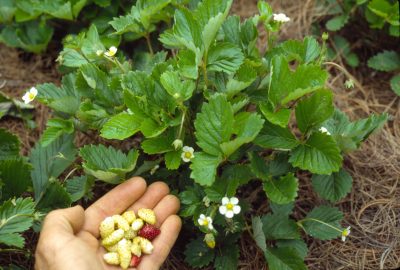
White and red alpine strawberries
They’re also quite small, with big ones about the size of a nickel. But they pack a lot of flavor and fragrance into that small package, and do so all summer long.
Problem is that birds eat the berries as soon as they’re just beginning to blush. If picked then, the flavor is akin to cotton soaked in lemon juice. Flavor and aroma don’t develop until they’re dead ripe.
So I grow WHITE alpine strawberries. Birds don’t see them and I can wait until they turn a creamy white color and the seeds darken.
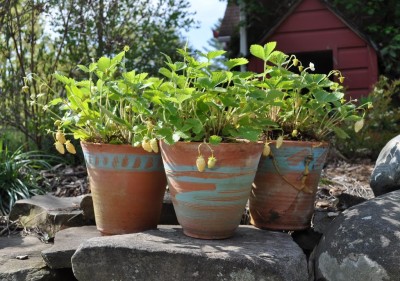
Alpine strawberries also fruit well in pots
At that point of ripeness, the berries are very, very soft, not something that could be picked for later sale, let alone shipping. Everybody who has tastes them exclaims “wow,” or something similar.
(If you’re hungry for more growing and historical details, alpine strawberries and black currants each get a chapter in my book Uncommon Fruits for Every Garden.)

